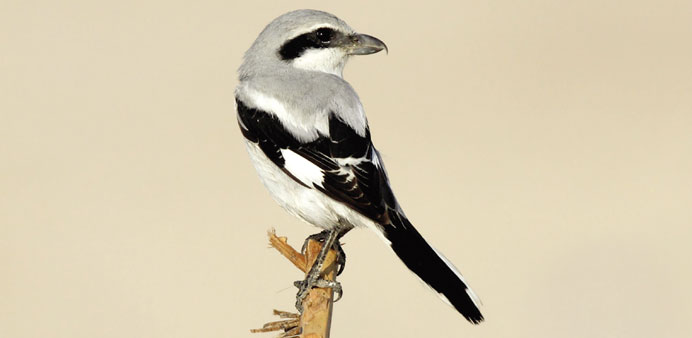Shrike Southern Grey. Photos by Neil Morris
One of eight flyways used by birds as they migrate around the world, 315 of such species fly by Qatar, of which 59 breed here — the remaining 256 are migratory species, according to a leading bird watcher.
By Fran Gillespie
Neil Morris is a man with a passion: bird watching. Hooked after being given his first pair of binoculars at the age of eleven, he went on to graduate in zoology and botany and then worked for the Royal Society for the Protection of Birds in the UK for a number of years.
Now based in Qatar, Morris is out and about several times a week recording his sightings, which already include several new species for Qatar, and is the co-author of the book Irkhaya: Biodiversity in Qatar recently launched by the Ministry of Environment.
In a presentation on his favourite subject to the Qatar Natural History Group, Morris explained that the reason why this small desert land is so rich in bird species — 315 at the last count — is that it lies in the path of the Great Africa-Asia Flyway, one of eight flyways used by birds as they migrate around the world.
Of the 315 species, he pointed out, only 59 breed here, the remaining 256 are migratory species and only appear in Qatar at a certain time of the year. Fifteen species recorded in Qatar are designated ‘globally endangered’. The size of a bird is no indication of its flight capabilities, said Morris, giving as an example the tiny Willow Warbler which migrates thousands of kilometres each year. Often birds fly so high on their long migration routes that they cannot be seen from the ground.
There is no doubt that before the discovery of oil transformed the future of Qatar and its citizens, lack of surface water meant that far fewer species stopped over for a few days or weeks to rest and regenerate their strength before moving on.
Now, the presence of grey water lagoons, arable farmlands, parks and gardens means that birds can find abundant water, food and shelter. Although this is a rare example of human development having a positive impact on wildlife, overall, said Morris, the future for many species worldwide looks grim, and he foresees ‘dramatic changes’ in world populations.
For the beginner, he pointed out, identification of birds can be tricky. Recognising its plumage is no guarantee of success: the Steppe Gull, for example, has five different plumages, changing with age. Males, females and juveniles of the Namaqua Dove have widely varying plumages.
Other species look almost identical: species of Grey Shrike for example, Willow Warblers and Chiffchaffs, and Marsh and Eurasian Reed Warblers. In the case of the warblers they moult at different times, so it’s important to have extra information about a species beyond its overall appearance as shown in bird books. Willow Warblers and Chiffchaffs can easily be distinguished by their very different songs — that is in regions where they sing.
The problem in Qatar is that, while stopping-over, many of the migratory species remain silent!
The movement of birds — what birders call their ‘jizz’ — can be a give-away. The attractive little Menetries Warblers constantly flick their long tails up and down, making them easy to identify even at a distance.
In recent research by scientists, DNA analysis has provided some surprising results. For example blackbirds, thrushes and robins, which were thought to be closely related, have now been shown to have been separated by evolution far more widely than was previously understood. And Yellow Wagtails have so many different colorations that for a long time they were thought to be different sub-species, but study of their DNA has proved them to be all the same bird.
“Governments will not put money into research on sub-species,” said Neil Morris, “so research like this is crucial if we are to persuade large corporations and governments to invest in trying to secure the future of some of the world’s endangered species.”
Now that the central area of arable farmland at Irkhaya in Qatar has been officially recognised for its importance in sustaining bird populations, with 76% of all the 315 species occurring there, it is hoped that more research will help Qatar will play a vital part in protecting the thousands of birds that pass through every year.
BELOW:
1) Shrike Arabian Grey
2) A Purple Gallinule Photo by Dileep Kumar
3) Chiffchaff
4) Warbler Willow

